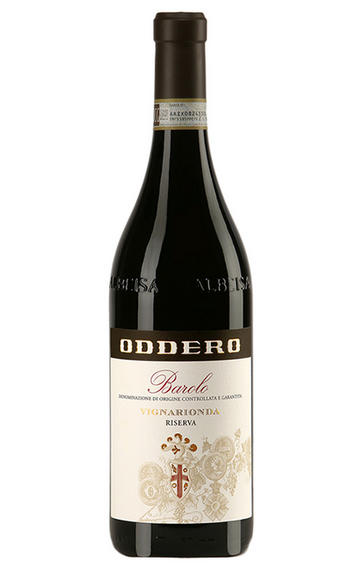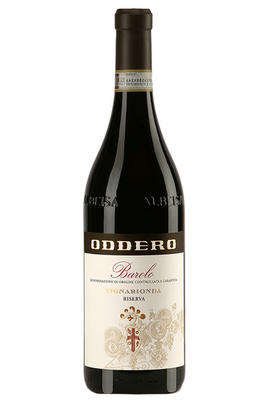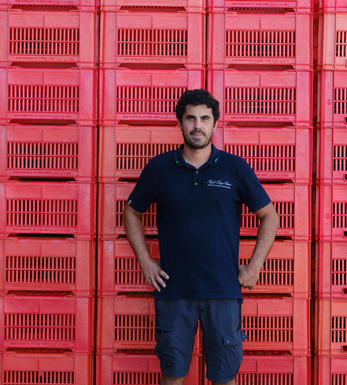
Barolo, Vigniarionda, Riserva, Oddero Vertical Collector's Case (2009 to 2014), Six-Bottle Assortment Case

About this WINE

Poderi e Cantine Oddero
One of the headline names of the region, the Oddero family has been producing wines from impressive vineyard holdings around Piedmont since 1878. Brothers Giacomo and Luigi Oddero grew the winery’s reputation as one of the Langhe’s most esteemed cantinas, amicably splitting the estate in 2006. Luigi passed away in 2009, having retained 32ha and many of the best vineyards, and cantina is now run by his widow and children.
Francesco Versio is the head winemaker here; hugely respected, he learnt his craft at Bruno Giacosa under Dante Scaglione before joining Figli Luigi Oddero in 2017. Now, there is new focus and a capable team in place. Francesco sees great opportunity here and maintains the ethos of this historical winemaking family, making traditional expressions with impressive technical judgement. The resulting wines are elegant and fine, with a vivid sense of origin.

Barolo
Located due south of Alba and the River Tanaro, Barolo is Piedmont's most famous wine DOCG (Denominazione di Origine Controllata e Garantita), renowned for producing Italy's finest red wines from 100 percent Nebbiolo.
Its red wines were originally sweet, but in 1840 the then extant Italian monarchy, the House of Savoy, ordered them to be altered to a dry style. This project was realised by French oenologist Louis Oudart, whose experience with Pinot Noir had convinced him of Nebbiolo's potential. The Barolo appellation was formalised in 1966 at around 1,700 hectares – only a tenth of the size of Burgundy, but almost three times as big as neighbouring Barbaresco.
Upgraded to DOCG status in 1980, Barolo comprises two distinct soil types: the first is a Tortonian sandy marl that produces a more feminine style of wine and can be found in the villages of Barolo, La Morra, Cherasco, Verduno, Novello, Roddi and parts of Castiglione Falletto. The second is the older Helvetian sandstone clay that bestows the wines with a more muscular style. This can be found in Monforte d'Alba, Serralunga d'Alba, Diano d'Alba, Grinzane Cavour and the other parts of Castiglione Falletto. Made today from the Nebbiolo clones Lampia, Michet and Rosé, Barolo has an exceptional terroir with almost every village perched on its own hill. The climate is continental, with an extended summer and autumn enabling the fickle Nebbiolo to achieve perfect ripeness.
Inspired by the success of modernists such as Elio Altare, there has been pressure in recent years to reduce the ageing requirements for Barolo; this has mostly been driven by new producers to the region, often with no Piedmontese viticultural heritage and armed with their roto-fermenters and barriques, intent on making a fruitier, more modern style of wine.
This modern style arguably appeals more to the important American market and its scribes, but the traditionalists continue to argue in favour of making Barolo in the classic way. They make the wine in a mix of epoxy-lined cement or stainless-steel cuves, followed by extended ageing in 25-hectoliter Slavonian botte (barrels) to gently soften and integrate the tannins. However, even amongst the traditionalists there has been a move, since the mid-1990s, towards using physiologically (rather than polyphenolically) riper fruit, aided by global warming. Both modernist and traditional schools can produce exceptional or disappointing wines.
Recommended traditionalist producers:
Giacomo Borgogno, Giacomo Conterno, Bruno Giacosa, Elio Grasso, Marcarini, Bartolo Mascarello and Giuseppe Mascarello.
Recommended nmdernist producers:
Azelia, Aldo Conterno, Luciano Sandrone, Paolo Scavino and Roberto Voerzio

Nebbiolo
Nebbiolo is the grape behind the Barolo and Barbaresco wines and is hardly ever seen outside the confines of Piedmont. It takes its name from "nebbia" which is Italian for fog, a frequent phenomenon in the region.
A notoriously pernickety grape, it requires sheltered south-facing sites and performs best on the well-drained calcareous marls to the north and south of Alba in the DOCG zones of Barbaresco and Barolo.
Langhe Nebbiolo is effectively the ‘second wine’ of Piedmont’s great Barolo & Barbarescos. This DOC is the only way Langhe producers can declassify their Barolo or Barbaresco fruit or wines to make an early-drinking style. Unlike Nebbiolo d’Alba, Langhe Nebbiolo can be cut with 15% other red indigenous varieties, such as Barbera or Dolcetto.
Nebbiolo flowers early and ripens late, so a long hang time, producing high levels of sugar, acidity and tannins; the challenge being to harvest the fruit with these three elements ripe and in balance. The best Barolos and Barbarescos are perfumed with aromas of tar, rose, mint, chocolate, liquorice and truffles. They age brilliantly and the very best need ten years to show at their best.


Buying options
Add to wishlist
Description
This six-bottle vertical case from Poderi e Cantine Oddero contains the following vintages:
1 x 2009 Barolo, Vigniarionda, Riserva - 94 points
This has deeply rich, dark berries and cherries in a complex mode, also delivering savory, spiced earth and aged meat notes. The palate has a sense of depth and detail with a long and flavorful core of succulent tannins. Ripe, dense and majestic. Drink or hold.
James Suckling, jamessuckling.com (Jan 2019)
1 x 2011 Barolo, Vigniarionda, Riserva - 94 points
A beautiful, late-release Barolo that shows red licorice, dried rose petals, fragrant Chinese spices, nutmeg, tar, cedar and leather. Medium-bodied with fine and velvety tannins, acidity with a good kick and a medium-chewy finish. Drink now.
James Suckling, jamessuckling.com (Nov 2019)
1 x 2012 Barolo, Vigniarionda, Riserva - 96 points
This is such a beautiful 2012 with silky, polished tannins and orange-peel, plum and cedar character. It’s medium-bodied with super fine tannins and a caressing finish. Rather juicy. Drink or hold.
James Suckling, jamessuckling.com (Jul 2021)
1 x 2014 Barolo, Vigniarionda, Riserva - 95 points
Pretty aromas of ripe strawberries, flowers and wet earth follow through to a medium to full body and firm tannins that are tight and poised, showing energy and vivacity. Excellent for this cool vintage and shows the excellence of this vineyard site. Give it time to soften. Better after 2023.
James Suckling, jamessuckling.com (Aug 2020)
2 x 2013 Barolo, Vigniarionda, Riserva - 96 points
Love the sweetness of fruit to this with plums, meat, flowers and mushrooms on the nose. The palate shows round, chewy tannins with a clear line of fruit in the center palate. It’s transparent and bright. Just starting to open now. Drink after 2023.
James Suckling, jamessuckling.com (Sep 2020)
wine at a glance
Delivery and quality guarantee